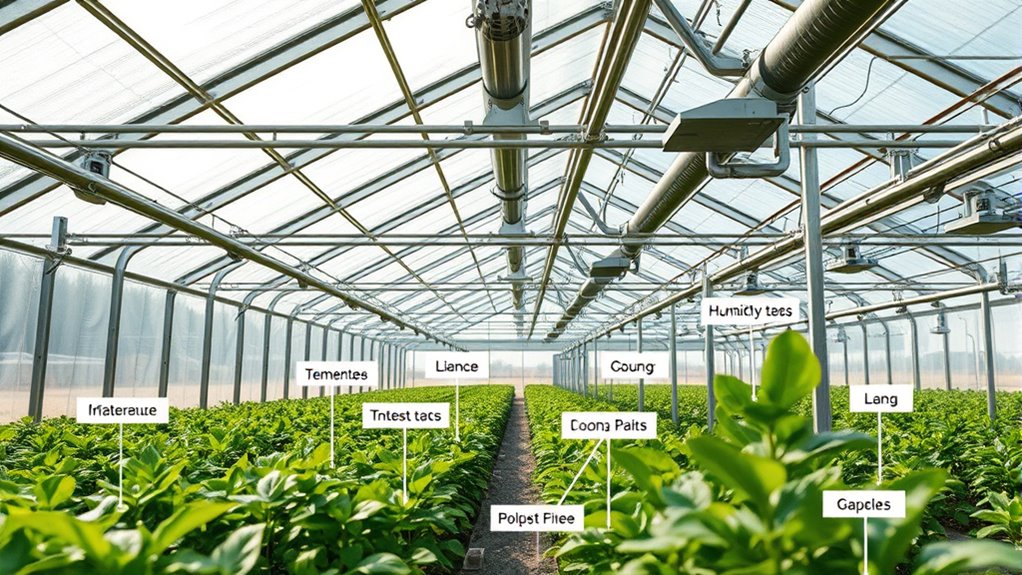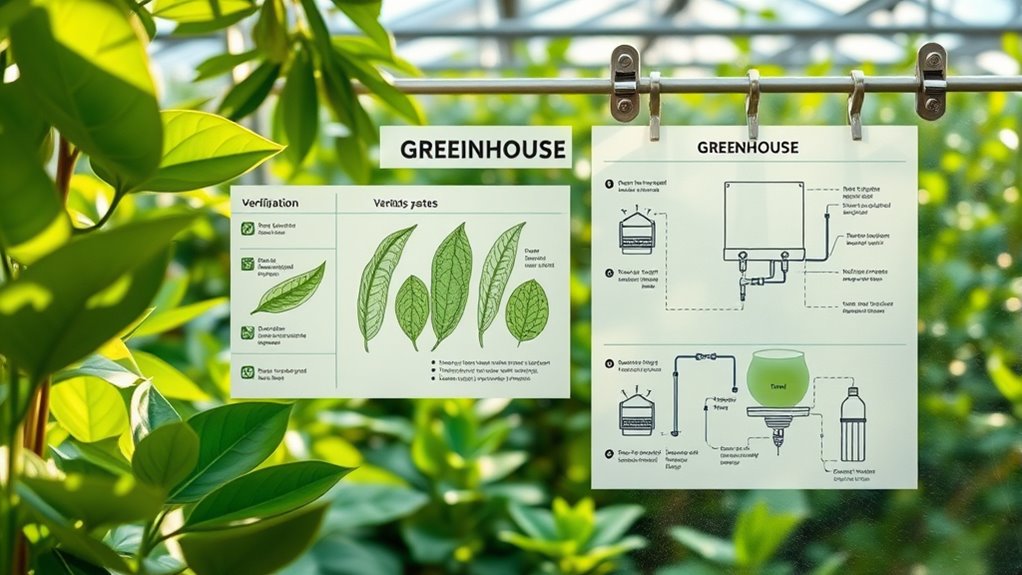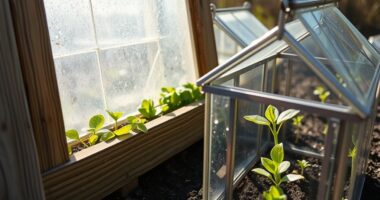A glossary of common greenhouse terms helps you understand essential concepts like climate control, pest management, and environmental components to optimize plant growth. You’ll learn about systems like heaters, fans, vents, and shade cloths that regulate temperature and humidity. Familiarity with terms related to pests, growing mediums, and lighting allows you to troubleshoot and improve your setup effectively. Exploring these terms further will give you the tools to create a healthier, more productive greenhouse environment.
Key Takeaways
- Defines essential greenhouse components like vents, shade cloths, and climate control devices for environment regulation.
- Explains pest management terms such as biological control, IPM, and traps to support sustainable crop protection.
- Clarifies structural and environmental concepts including growing mediums, ventilation, and humidity control.
- Covers light management terminology like supplemental lighting and shading to optimize plant growth conditions.
- Highlights operational terms related to greenhouse efficiency, troubleshooting, and resource optimization strategies.

Understanding greenhouse terminology is essential for anyone interested in sustainable agriculture or environmental conservation. When you’re working with a greenhouse, knowing key terms helps you make informed decisions about climate control and pest management, guaranteeing ideal plant growth and healthy yields. Climate control refers to the systems and methods you use to regulate temperature, humidity, and airflow inside the greenhouse. Proper climate control creates an ideal environment, preventing extreme temperatures or moisture levels that could stress plants or invite pests. You might use heaters, fans, shade cloths, or ventilation systems to maintain this balance. Recognizing how these components interact allows you to fine-tune conditions, reducing energy costs and improving plant health.
Understanding greenhouse systems helps optimize climate control for healthy, thriving plants.
Pest management is another critical aspect of greenhouse operation. It encompasses strategies and techniques to prevent, detect, and control pests that threaten crops. A good understanding of pest management terms helps you identify pests early and choose effective control methods, minimizing chemical use and promoting sustainable practices. For example, integrated pest management (IPM) blends biological, cultural, and mechanical control measures to keep pest populations in check. You might introduce beneficial insects, use sticky traps, or practice crop rotation to reduce pest pressure. Knowing these terms helps you implement proactive strategies that protect your plants without harming the environment.
Many greenhouse-related terms also relate to the physical structure and environment. For instance, a vent is a crucial component of climate control, allowing excess heat and humidity to escape, which prevents overheating and mold growth. An **automatic vent opener** can adjust vents based on temperature, maintaining consistent conditions without manual effort. The growing medium—such as soil or hydroponic solutions—affects water retention and nutrient availability, impacting plant health and pest susceptibility. Understanding these terms helps you troubleshoot issues quickly and optimize your setup. Additionally, understanding climate control systems enables you to reduce energy consumption and optimize resource use, which is vital for sustainable greenhouse management.
Additionally, concepts like light management are important. Greenhouses often use shade cloths or supplemental lighting to ensure plants receive the right amount of light, influencing growth and flowering. Proper light levels also play a role in pest management; healthy, vigorous plants are less likely to be overwhelmed by pests. When you familiarize yourself with these terms, you develop a comprehensive understanding of how each element interacts, allowing you to create a controlled environment that promotes plant vitality and reduces pest-related problems.
In essence, grasping greenhouse terminology empowers you to operate more efficiently, respond swiftly to issues, and implement sustainable practices. Whether it’s fine-tuning climate control systems or managing pests effectively, knowing the language of greenhouses helps you achieve consistent success in your horticultural endeavors.
Frequently Asked Questions
How Do I Choose the Right Greenhouse Size for My Needs?
To select the right greenhouse size, start by evaluating your gardening goals and the types of plants you want to grow. Think about greenhouse dimensions that fit your available space and allow for proper space planning. Consider how much room you’ll need for plant growth, work areas, and equipment. Picking a size that balances your current needs with potential expansion helps ensure your greenhouse remains functional and enjoyable.
What Are the Best Plants for Beginner Greenhouse Gardeners?
Start with easy-to-grow plants like herbs, leafy greens, and succulents for your greenhouse. These plants thrive with minimal fuss, quick growth, and forgiving care. Succulent selection is perfect because they require less water and care. Container gardening makes it simple to manage soil and watering needs. By choosing these beginner-friendly options, you set yourself up for success, enjoying lush greenery and fresh produce without feeling overwhelmed.
How Can I Reduce Humidity Levels in My Greenhouse?
To reduce humidity levels in your greenhouse, start by installing a dehumidifier suited to your space, which effectively pulls excess moisture from the air. You can also improve ventilation by opening vents or adding exhaust fans, promoting airflow. When selecting a dehumidifier, consider its capacity relative to your greenhouse size. Avoid overwatering plants, as this adds to humidity, and regularly monitor humidity levels to maintain a healthy environment.
What Are Common Pests Found in Greenhouses and How to Control Them?
Like a modern-day knight, you must identify common pests such as aphids, whiteflies, and spider mites in your greenhouse. Use pest identification techniques to spot them early, then opt for organic pest control methods like neem oil, insecticidal soaps, or introducing natural predators. Regular monitoring and maintaining cleanliness help prevent infestations, ensuring your plants stay healthy and thriving without resorting to harsh chemicals.
How Does Seasonal Temperature Variation Affect Greenhouse Plant Growth?
Seasonal temperature fluctuations directly impact your greenhouse plant growth, requiring you to adapt your methods. As temperatures vary, plants may slow growth or become stressed if it’s too cold or hot. To optimize growth, you should adjust heating and cooling systems, provide shade during hot periods, and insulate during cold months. These strategies help your plants adapt to seasonal temperature fluctuations, ensuring healthy growth year-round.
Conclusion
Now that you understand these greenhouse terms, you’re better equipped to optimize your setup. Picture a small backyard greenhouse where you adjust humidity with a dehumidifier to prevent mold. By knowing the difference between transpiration and evaporation, you can fine-tune watering schedules for healthier plants. With this knowledge, you’ll confidently create a thriving environment—turning your greenhouse into a lush, productive oasis.









